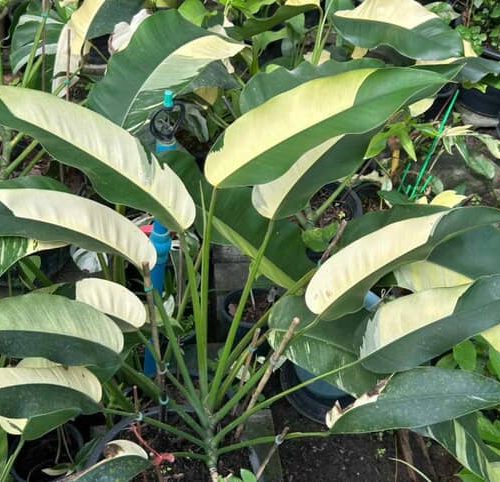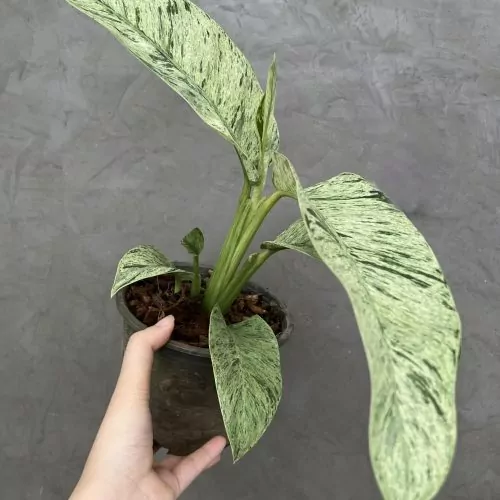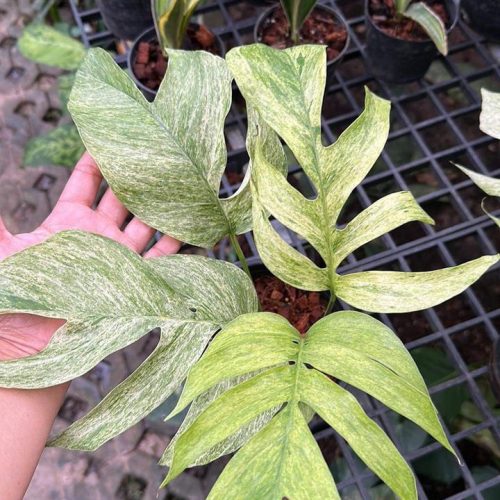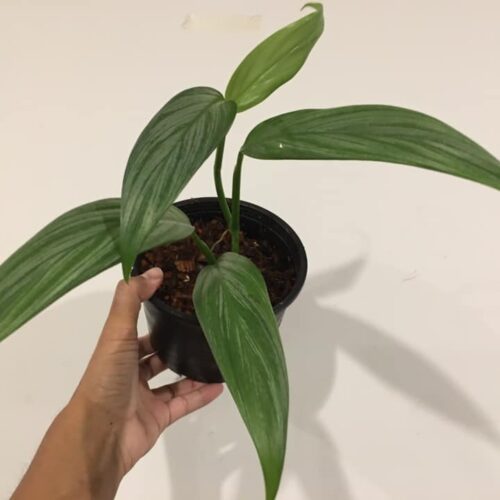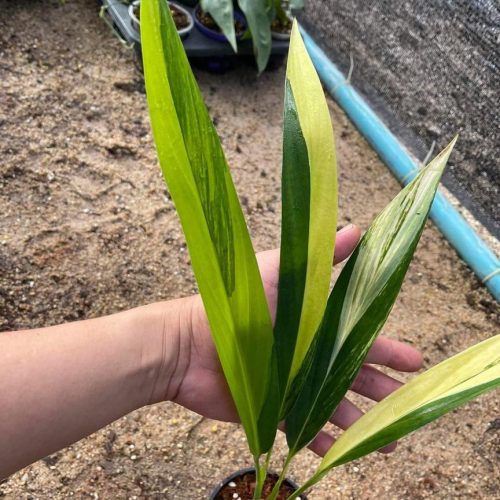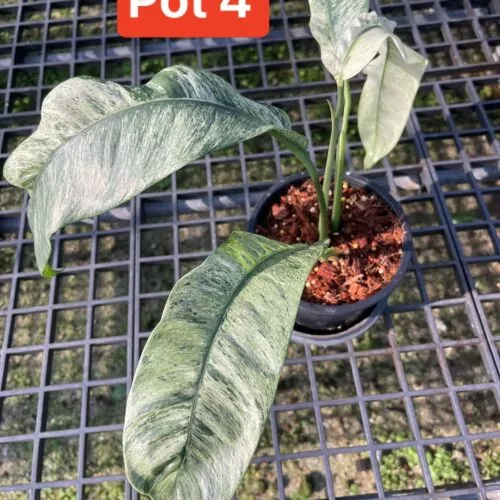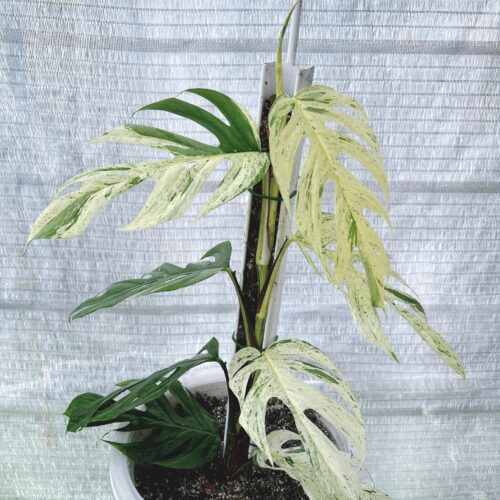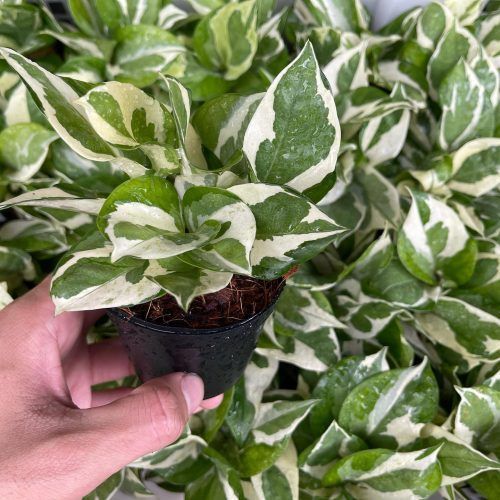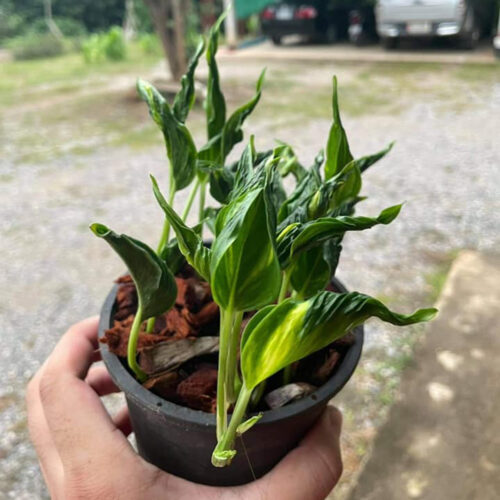Epipremnum Pinnatum Mint is a gorgeous and easy to care for houseplant. With its heart-shaped leaves in shades of minty green and cream, this plant adds a pop of color and vitality to any indoor space. In this blog post, we’ll explore everything you need to know about growing and caring for this tropical beauty.
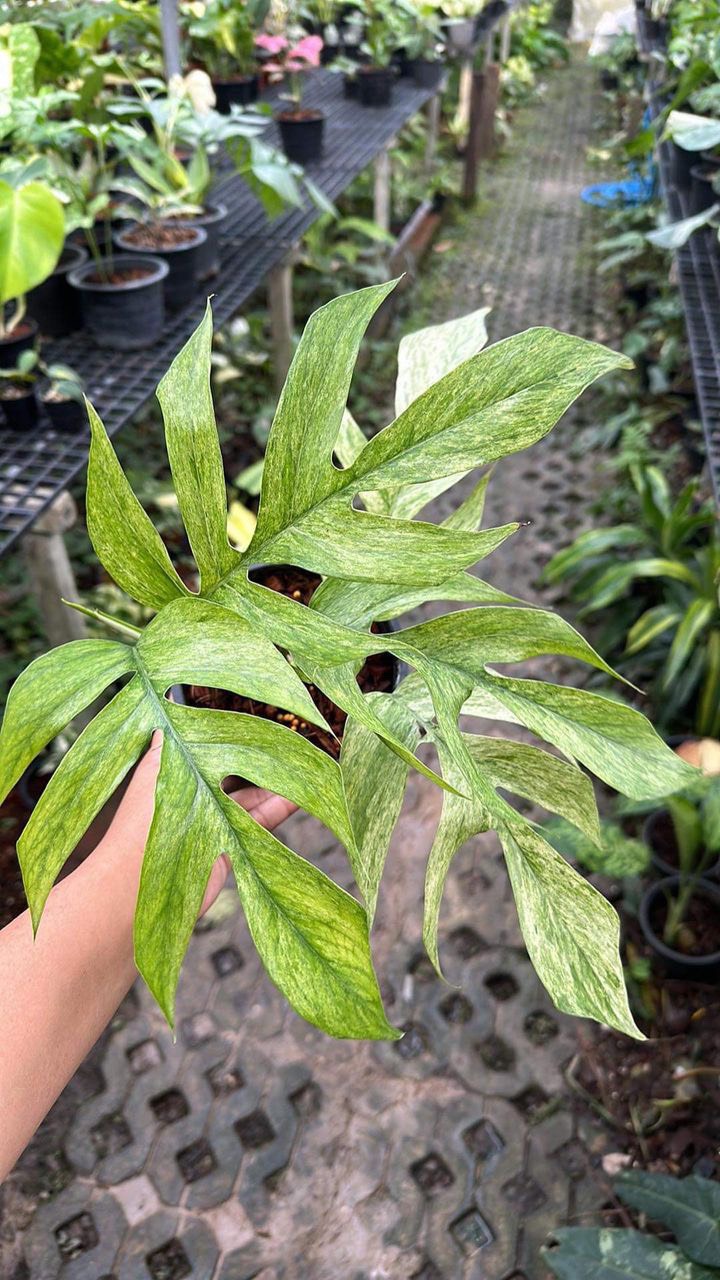
Basic Plant Information
Epipremnum Pinnatum Mint is a cultivar of Epipremnum Pinnatum, which is commonly known as Pothos or Devil’s Ivy. It features oval-shaped leaves in a minty green and creamy white variegation.
Leaf Description
The leaves of the Epipremnum Pinnatum Mint have a neon green color towards the center that graduates into a creamy, yellowish white along the edges. The variegation pattern is random, giving each leaf a unique appearance. Mature leaves can grow up to 10 inches long. They have a waxy texture and a somewhat puckered surface.
Growth Habit
In its native jungle habitat, Pothos is a fast-growing vine that can climb up tree trunks. As a houseplant, Epipremnum Pinnatum Mint has a trailing or cascading growth habit. It can be grown in hanging baskets or trained to climb up a moss pole. The long vines look spectacular when allowed to drape down from shelving.
For those curious about the diverse range of Epipremnum varieties, I suggest exploring “5 Stunning Epipremnum Varieties: A Must-See Guide!“. This guide offers a fascinating look into the various types of Epipremnum, showcasing the unique features and qualities of each.”
Growing Conditions
Epipremnum Pinnatum Mint thrives under average home conditions. It is adaptable but does best in bright, indirect light with moderate humidity.
Light Requirements
Epipremnum Pinnatum Mint prefers bright, filtered light but can tolerate low to medium indirect sunlight. Keep it near an east or west-facing window where it will get a few hours of sun a day without getting scorched by intense afternoon sun from the south. Fluorescent office lighting also works well. Rotate the plant occasionally so all sides get adequate light exposure.
Watering and Soil Needs
Water when the top inch of soil becomes dry to the touch. Take care not to overwater as soggy soil can cause root rot. The plant enjoys slightly moist soil but does need time to dry out in between waterings. An all-purpose potting mix works well and helps provide drainage. Add perlite or orchid bark to further aerate the soil.
Humidity and Temperature Preferences
Epipremnum Pinnatum Mint enjoys average household humidity of 40-50% but also tolerates lower humidity environments remarkably well compared to other tropical plants. Misting the leaves occasionally can help boost moisture when indoor air is very dry. Ideal temperatures are between 60°F to 80°F.
To gain more insights into creating the ideal environment for your Epipremnum, whether indoors or outdoors, you’ll find valuable information in “5 Essential Tips for Thriving Epipremnum Indoors & Outdoors“. This article provides detailed advice on how to nurture these beautiful plants in different settings.

“Transform your space into a green sanctuary! Click now to purchase the stunning Epipremnum Pinnatum Mint and bring a touch of nature’s elegance to your home.”
Where to buy Epipremnum Pinnatum Mint? Benefits from importing plants from Thailand
- Shipping: Door to door shipping, fast and safe with Dragon Courier
- Biodiversity: Thailand is known for its rich biodiversity, including a wide variety of aroid species. This diversity allows importers to access a broad range of unique and exotic aroid plants.
- Quality and Health of Plants: The suitable climate helps the plants grown here stay healthy and of high quality.
- Cost-Effectiveness: Due to favorable growing conditions and efficient production methods, Thai aroid plants can often be more cost-effective compared to those from other countries.
- Access to Hybrid Varieties: Thai growers are often involved in the development of new hybrid aroid varieties, offering unique plants that may not be available from other sources.
Epipremnum species are the most sought after by aroid plant lovers
Tips for Growing a Healthy Epipremnum Pinnatum Mint
Here are some helpful care tips to keep your Epipremnum Pinnatum Mint thriving for years to come:
Fertilization
Apply a balanced liquid fertilizer at half strength every two weeks in spring and summer during the active growing season. This provides vital nutrients needed for lush foliage growth.
Pruning
Trim off any dead or damaged leaves at the base of the stem to keep your plant looking its best. Also pinch back leggy stems to encourage bushier growth.
Support for Optimal Growth
As Epipremnum Pinnatum Mint matures, the vining stems can grow quite long and get unruly. Provide plant supports like a moss pole or trellis which encourages climbing growth and shows off those gorgeous variegated leaves to perfection.
Propagation
Take 4-6 inch stem cuttings and root them in water or moist soil to easily propagate new plants. This Pothos cultivar is incredibly easy to propagate which means lots of babies to share!
If you’re new to plant propagation or want to ensure success with your Epipremnum cuttings, check out “5 Easy Steps to Multiply Your Golden Pothos at Home!“. This resource gives a straightforward guide on propagating Epipremnum varieties, making it easy for even beginners to expand their collection.

Interesting Facts About Epipremnum Pinnatum Mint
Beyond being a gorgeous houseplant, Epipremnum Pinnatum Mint has some fascinating facts about its history and uses:
- Has a centuries-long history of use in Traditional Chinese Medicine to treat infections and inflammation when applied topically. The sap was found to contain beneficial antimicrobial compounds.
- Features prominently in Hindu legends, art, and Ayurvedic medicine where the plant represents prosperity and eternal life.
- Was used by Native Hawaiian people for making grass skirts and ceremonial leis because it holds up well compared to more delicate tropical flowers. The plant itself was considered sacred.
- Was a hugely popular Victorian era houseplant in the 1800s after being brought over from tropical Pacific Islands. Its graceful trailing habit was shown off in elegant Wardian cases.
- Has air purifying abilities – NASA Clean Air Study found it filters out benzene, trichloroethylene, and formaldehyde from indoor air which helps remove pollutants.
So not only is Epipremnum Pinnatum Mint exceptionally easy-care and lovely to look at, it also has some fabulous historical and healthful properties that make it even more special as a houseplant!
Conclusion
With its whimsical minty and cream variegated foliage, Epipremnum Pinnatum Mint adds eye-catching and refreshing style to indoor garden decor. This Pothos cultivar is unfussy, versatile, and easy to grow, tolerating a wide range of household conditions. Provide it bright indirect light, average room temperatures, occasional misting or grouping with other plants to boost humidity, and well-draining soil that is allowed to dry out some between waterings. That’s all it takes to keep your Epipremnum Pinnatum Mint thriving for years of enjoyment! Its fast growth, trailing habit, and ability to remove indoor air pollutants make this a wonderful low-maintenance houseplant sure to enhance any space.
FAQs
Is Epipremnum Pinnatum Mint toxic to pets?
Yes, like many common houseplants, all parts of Epipremnum Pinnatum Mint are toxic to both cats and dogs if ingested. The plant irritant calcium oxalate crystals can cause oral irritation, vomiting and difficulty swallowing if large quantities are consumed. Keep plants safely out of pet’s reach.
Why are some leaves turning yellow?
If older leaves start yellowing, it usually indicates overwatering or poor drainage. Allow soil to dry out between waterings and make sure the pot has drainage holes to prevent soggy soil issues. Leaf yellowing can also be from lack of nutrients or insufficient light.
Why do leaf tips turn brown?
If leaf tips turn brown and crispy while the rest of the leaf remains healthy and green, it is likely due to dry air. This plant prefers 40-50% humidity which can be hard to achieve indoors in winter or in arid climates. Group plants together, use a humidifier, or mist leaves to boost moisture.
How can I revive a struggling plant?
Start by thoroughly checking over the entire plant and removing any rotting stems or foliage, then assess care. Ensure it receives bright indirect light, prune back any overgrown vines, fertilize monthly, water only when the top inch of soil is dry to touch, and make any needed improvements to soil, drainage, or humidity. Usually, adjusting one or more of these key growing requirements revives struggling Epipremnum Pinnatum Mint.

